Edward Leedskalnin
| Edward Leedskalnin | |
|---|---|
.jpg) Edward Leedskalnin, c1910 | |
| Born |
Edvards Liedskalniņš 12 January 1887 Stāmeriena Parish, Livonia, Russian Empire |
| Died |
7 December 1951 (aged 64) Miami, Florida, U.S. |
| Nationality | Latvian[1] |
| Known for | Coral Castle |

Edward Leedskalnin (modern Latvian: Edvards Liedskalniņš) (January 12, 1887 – December 7, 1951) was a Latvian emigrant to the United States, self-taught engineer and sculptor who single-handedly built the Coral Castle in Florida, added to the National Register of Historic Places in 1984.[2] Leedskalnin was also known for developing theories of magnetism.
Life
Edward Leedskalnin was born on January 12, 1887 in Stāmeriena Parish, Latvia. Little is known of his childhood, aside from the fact that his parents were not wealthy and he received only a fourth-grade formal education. Edward was a sickly boy who often spent time reading books, which helped him to develop an inquisitive mind and life-long yearning for knowledge. It was suggested that he learned stonemasonry from his father and practiced this craft in Latvia after coming of age.[3]
At the age of 26 he was engaged to marry Agnes Skuvst who was ten years younger.[4] However, the girl who Leedskalnin later referred to as his "Sweet Sixteen" broke the engagement, so he decided to emigrate to North America.[5]
On April 7, 1912 Leedskalnin arrived in New York City. After looking for suitable work at the East Coast till August, he relocated to the Pacific Northwest, which was experiencing a logging boom. On June 5, 1917 he filled in his draft registration in Oregon stating that he was self-employed and engaged in ax-handle manufacturing. The 1920 census data reveal that he resided in Reedsport, Oregon.[3]
In the winter of 1922–1923, after allegedly contracting tuberculosis, Leedskalnin moved to the warmer climate of Florida, where he purchased an undeveloped parcel of land in Florida City, which at the time was lightly inhabited.[3] On February 27, 1923 The Homestead Enterprise newspaper published a notice that "E. Leedskalnin a Californian has purchased an acre of the R. L. Moser homestead and is planning to erect a home soon."[3]
Over the next 20 years, Leedskalnin constructed a massive structure that he called "Rock Gate" and dedicated, in his own words, to the girl who had left him years before. Working alone and mostly at night, Leedskalnin eventually quarried and sculpted over 1,100 short tons (997,903 kg) of oolite limestone into architectural and engineering landmark that would later be known as the Coral Castle.[6] He used various basic tools available under his modest means including salvaged timber and old automobile parts. First, he built a house out of limestone blocks and wood, then he gradually constructed the stone structure for which he is now famous.[5] Despite his reserved personality, he eventually opened the Coral Castle to the public, offering tours for 10 cents.[3]
When people were asking Leedskalnin how he had moved all of the heavy stone on his own, he usually replied, "I understand the laws of weight and leverage and I know the secrets of the people who built the pyramids", referring to the pyramids at Giza, Egypt.[7] Some local residents later remembered that as school children they had field trips to the construction site of the future Coral Castle, and Leedskalnin personally explained manual methods of his work.[3] * Citation is missing page number, please correct.
In the 1920s, the structure with assortment of sculpted stones was located in Florida City; then, in the mid-1930s, Leedskalnin hired a truck with a driver to move it to its present location on a 10-acre (4.0 ha) site in the adjacent Homestead, Florida.[5] On November 9, 1951 he checked himself into Jackson Memorial Hospital in Miami. Apparently, Leedskalnin suffered a stroke either before he left for the hospital or at the hospital. He died twenty-eight days later of pyelonephritis (kidney infection) at the age of 64. His death certificate noted that his death was a result of "uremia; failure of kidneys, as a result of the infection and abscess."[3]
- The Coral Castle
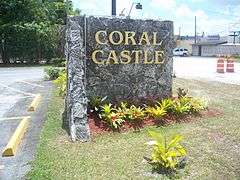
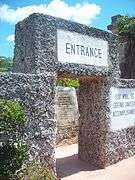
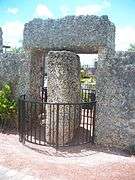

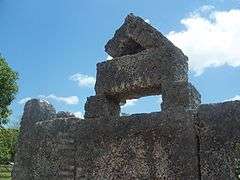
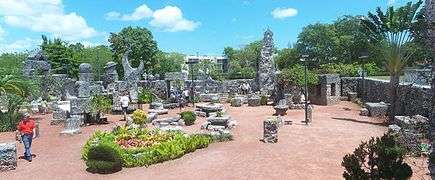


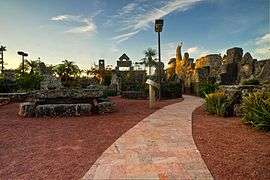

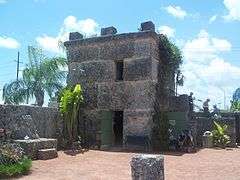

Writings
During his lifetime Leedskalnin published five pamphlets on various subjects, advertising them in local newspapers.
Magnetic Current was first published in 1988 and the only source for any of these pamphlets is the Coral Castle gift shop.
Moral education
His first and longest booklet, a treatise on moral education, is printed on only the left-hand pages, and begins with the following preface:
"Reader, if for any reason you do not like the things I say in the little book, I left just as much space as I used, so you can write your own opinion opposite it and see if you can do better."
— The Author
In the first section, Leedskalnin vents his anger at his "Sweet Sixteen", arguing that girls should be kept pure, and that boys are primarily a soiling influence upon them. On page 4 of A Book in Every Home, Leedskalnin writes:
"Everything we do should be for some good purpose but as everybody knows there is nothing good that can come to a girl from a fresh boy. When a girl is sixteen or seventeen years old, she is as good as she ever will be, but when a boy is sixteen years old, he is then fresher than in all his stages of development. He is then not big enough to work but he is too big to be kept in a nursery and then to allow such a fresh thing to soil a girl — it could not work on my girl. Now I will tell you about soiling. Anything that is done, if it is done with the right party it is all right, but when it is done with the wrong party, it is soiling, and concerning those fresh boys with the girls, it is wrong every time."
The second section continues along the theme of moral education, with several aphorisms aimed at parents regarding the proper way to raise children. The last, "Political" section, reveals that the reclusive Leedskalnin had strong political views. He advocates voting for property owners only (and in proportion to their holdings), and argues that "Anyone who is too weak to make his own living is not strong enough to vote."
Some writers have suggested that Leedskalnin's booklet contains further information on his electromagnetic research and philosophies encoded in its pages, and the blank pages are provided for the reader to fill in their decrypted solutions. It has also been suggested that Leedskalnin's frequent referral to his "Sweet Sixteen" may in fact refer to the numerological and/or scientific relevance of the number sixteen to his research and theories.[8]
Leedskalnin's ideas may appear unusual. He wrote that a mother's most important task is to ensure that her daughter remains "chaste and faithful":[5]
"In case a girl's mamma thinks that there is a boy somewhere who needs experience then she, herself, could pose as an experimental station for that fresh boy to practise on and so save the girl. Nothing can hurt her any more. She has already gone through all the experience that can be gone through and so in her case it would be all right."
Magnetism
Leedskalnin became interested in the general theory of magnetism.[9] His four pamphlets addressed interaction of electricity, magnetism and the body; Leedskalnin also included a number of simple experiments to validate his theories.
Contradicting the standard model of electromagnetism, his thesis is based upon the theory that the metal itself is not the magnet and that the real magnets are circulating in the metal. These individual north and south pole magnets are particles smaller than atoms or photons and each particle in the substance was an individual magnet by itself.[10]
Leedskalnin claimed that all matter was being acted upon by what he called "individual magnets". He also claimed that scientists of his time were looking in the wrong place for their understanding of electricity and that they were observing only "one half of the whole concept" with "one sided tools of measurement". For instance:
"Magnets in general are indestructible. For instance you can burn wood and flesh. You can destroy the body, but you cannot destroy the magnets that hold together the body. They go somewhere else. Iron has more magnets than wood, and every different substance has a different number of magnets that hold the substance together. If I make a battery with copper for positive terminal and beef for negative terminal I get more magnets out of it than when I used copper for positive terminal and sweet potato for negative terminal. From this you can see that no two things are alike."[5]
Works
- Leedskalnin, Edward (1936). A Book in Every Home. Containing Three Subjects: Ed's Sweet Sixteen, Domestic and Political Views (Reprinted ed.). Health Research Books. ISBN 9780787313906.
- Leedskalnin, Edward (1988) [1945]. Magnetic current; Mineral, vegetable & animal life. Mokelumne Hill, California: Mokelumne Press.
- Leedskalnin, Edward (1945). Magnetic current. Homestead, Florida: Rock Gate. * The link directs to a forum fan-made copy with user added illustrations that may mislead. Obviously not published in 1945.
- Please cite/source the above works. The first time magnetic current was published was 1988 (supposedly a reproduction of a 1945 self-published work that no one has ever seen and no copies/pictures of exist today including newspaper advertisements that ought be verifiable). Without verification or indication that Leedskalnin actually wrote these pamphlets it would seem most likely that they were created in the mid- to late-1980s specifically to sell at the Coral Castle gift shop. Anyone with verifiable factual knowledge regarding Leedskalnin's supposed pamphlets please add/correct the above.
In popular culture
Ed Leedskalnin and his megalithic creation, Rock Gate, better known as Coral Castle, became a part of the American popular culture due to the magnitude of a single man's effort, perseverance, and determination.[11][12] With the advent of the Internet, Leedskalnin's fame spread far beyond Florida. Along with the recognition came speculations about his seemingly superhuman powers: either it was his purported access to alien technology or esoteric ancient knowledge, or his assumed ability to levitate blocks of stone and move them with the aid of the Earth's magnetic energy.[13][14][12]:213 Other currently available explanations center on Leedskalnin's stonemason and logging experiences that presumably allowed him to apply his work skills creatively to a tedious process of moving large blocks of stone using levers, wheels, axles, pulleys, ramps, and wedges without any power equipment.[15][16][17]
The emotional side of Ed Leedskalnin's life story drew the attention of songwriters and performers, including:
- Billy Idol recorded the song "Sweet Sixteen" for his Whiplash Smile album. It was based on the love story of Leedskalnin and his runaway girl. The music video was recorded at Coral Castle in 1986.[18]
- The Brooklyn-based band Piñataland recorded a song about Leedskalnin, titled "Latvian Bride", for their 2003 album Songs for the Forgotten Future Vol. 1. Douglas Stone, band's musician, said:[19]
"Latvian Bride" is about Ed Leedskalnin, who apparently defied the laws of physics to build the Coral Castle as a monument to his lost love (who was just 16 when she broke off their engagement.) It’s a very romantic (if occasionally creepy) story...
- Andrew Peterson recorded a song, "The Coral Castle", in his Carried Along (2002) studio album that evoked Leedskalnin's broken heart story.
See also
- Viktor Schauberger
- Simon Rodia
- Electromagnetic lock — about the "Magnetic Motion Holder" experiment of magnetic current
References
- ↑ Ed Leedskalnin's Coral Castle: A mysterious castle built as a monument to lost love, Atlas Obscura
- ↑ Coral Castle, National Register of Historic Places Information System ID: 84000840
- 1 2 3 4 5 6 7 McClure, Rusty; Heffron, Jack (2009). Coral Castle: The Mystery of Ed Leedskalnin and His American Stonehenge. Ternary Publishing. ISBN 9780984213214.
- ↑ Historians from Latvia provide different name and age — Hermīne Lūse, two years younger than Edward. Māris Goldmanis, Researcher at University of Latvia. Edward Leedskalnin and his Coral Castle in Florida, Latvian History, January 11, 2014.
- 1 2 3 4 5 Michell, John. Eccentric Lives and Peculiar Notions: With 56 Illustrations. Kempton, Ill: Adventures Unlimited Press, 1999. ISBN 978-0-932813-67-1.
- ↑ The Coral Castle. In Ellison, Emily and Perry, Chuck. Liars And Legends: The Weirdest, Strangest, And Most Interesting Stories and People From The South. Nashville, Tennessee: Rutledge Hill Press, 2005. ISBN 9781401602031
- ↑ Sidonie Sawyer. The Love Castle - a Weird Miami Landmark, The Huffington Post, May 27, 2014.
- ↑ "The Complete Writings of Edward Leedskalnin". Leedskalnin.com. Retrieved 2014-05-19.
- ↑ Edward Leedskalnin. Magnetic Current. Homestead, Florida, Rock Gate, 1945.
- ↑ Matt Emery. Double helical magnetic interaction, Leedskalnin.com: Magnetic Current Research
- ↑ Edward Leedskalnin (1886-1951): Environment/Yard Artist. In Congdon, Kristin G., and Kara Kelley Hallmark. American Folk Art: A Regional Reference. Santa Barbara, Calif: ABC-CLIO, 2012, pp. 227-229.
- 1 2 Knight, Gladys L. Pop Culture Places: An Encyclopedia of Places in American Popular Culture. Westport: Greenwood Press, 2014, p. 211-214.
- ↑ Peter Hancock. The Making of a Modern Myth: Edward Leedskalnin & The Coral Castle, Sceptic, December 12, 2005.
- ↑ Vince Daczynski. Edward Leedskalnin’s Coral Castle, Unexplained Mysteries
- ↑ John Martin (2012). "Coral Castle Construction: How One Man Created a Megalithic Wonder". ISBN 9780988429703
- ↑ Irwin, Orval M. (1996). Mr. Can't Is Dead: The Story of the Coral Castle. Homestead, Florida.
- ↑ Benjamin Radford. Mystery of the Coral Castle Explained. Live Science, November 8, 2013.
- ↑ Kevin Wuench. Monday lost and found: The bizarre story behind Billy Idol's 'Sweet Sixteen', Tampa Bay Times, June 2, 2014.
- ↑ Interview with Douglas Stone, Swordfish: Justin Vellucci on Music. Originally published in Delusions of Adequacy, September 27, 2004.
Further reading
- McClure, Rusty; Heffron, Jack (2009). Coral Castle: The Mystery of Ed Leedskalnin and His American Stonehenge. Ternary Publishing. ISBN 9780984213214.
- Childress, David Hatcher (1987). AntiGravity and the World Grid. Adventures Unlimited Press. ISBN 9780932813039.
- Congdon, Kristin G.; Hallmark, Kara Kelley (2012). American Folk Art: A Regional Reference. ABC-CLIO. ISBN 9780313349379.
- Ellison, Emily; Perry, Chuck (2005). Liars And Legends: The Weirdest, Strangest, And Most Interesting Stories and People From The South. Thomas Nelson. ISBN 9781401602031.
- Stavro, Andris. Koral̦l̦u pils: Edvarda Liedskalnin̦a Koral̦l̦u pils ir uzn̦emta Amerikas Savienoto Valstu Vēsturisko vietu nacionālajā reg̓istrā. Rīga: LA izdevniecība, 2005. ISBN 9789984542430
External links
- Coral Castle Museum
- Compilation of the published writings of Edward Leedskalnin
- David Carr, Independent Researcher and Writer, Investigating Coral Castle, July 8, 2014.
- Ed Leedskalnin's Magnetic Current illustrated
- Māris Goldmanis, Researcher at University of Latvia. Edward Leedskalnin and his Coral Castle in Florida, Latvian History, January 11, 2014.